Abstract
This study conducts a comprehensive systematic review to gain insights into the challenges of technology adoption and innovation for Malaysian Micro, Small and Medium-sized Enterprises (MSMEs), which play a crucial role in the country’s economy. These MSMEs face obstacles, including challenges in adopting technology and a lack of technical efficiency. To address these issues, the study explores prominent technology adoption theories (e.g. TAM, DOI) and organizational theories (e.g. RBV, ST). By addressing these challenges, policymakers can enhance MSMEs’ competitiveness through targeted strategies, fostering innovation and effective technology adoption, thus contributing to their growth and resilience in the Malaysian economy.
PUBLIC INTEREST STATEMENT
This study delves into the challenges encountered by Malaysian micro, small, and medium enterprises (MSMEs) in adopting technology and fostering innovation. As crucial contributors to Malaysia’s economy, MSMEs drive employment and economic growth. However, they face hindrances such as challenges of adoption and lack of technical efficiency. By exploring theories of technology adoption and organizational management, this study offers valuable insights for policymakers to enhance MSMEs’ competitiveness. Emphasizing innovation and effective technology adoption can bolster these businesses, making them more resilient in the Malaysian economy. The study presents recommendations for future research and implications to support MSMEs in embracing technology and nurturing a culture of innovation. By implementing these measures, policymakers can pave the way for MSMEs’ success and advancement in the global market, benefiting the entire society.
1. Introduction
Malaysian MSMEs are a vital contributor to the national economy, playing a crucial role in employment creation, strengthen innovations, and driving economic growth (Abd Aziz et al., Citation2019, Citation2021, Citation2021). In recent years, there has been a noticeable trend of emerging Malaysian MSMEs, with their numbers increasing from 1,151,339 in 2020 to 1,204,987 in 2022 (Department of Statistic Malaysia, Citation2022). Malaysian MSMEs contributed significantly to the country’s economy in 2021, accounting for 37.4% of the Gross Domestic Product (GDP) and generating a value added of RM518.1 billion. They also played a crucial role in driving business growth, being responsible for 97.4% of the total growth and the share of employment in MSMEs was 47.8% in 2021 (DOSM, Citation2021). MSMEs in Malaysia also made a notable contribution to the country’s exports in 2021, accounting for 11.7% of the share export, the main export destinations were China, Singapore and Hong Kong (DOSM, Citation2021). Despite their hugely growing contribution to Malaysia’s economy, MSMEs have been severely affected by the COVID-19 health crisis (DOSM, Citation2021). In particular, the implementation of the nationwide Mobility Control Order (MCO) led to a decline in the performance of all sectors of the economy. Moreover, the insufficient emphasis on innovation among MSMEs in Malaysia has led to a lower rate of technology adoption than expected (Abdul Halim et al., Citation2018). Compared to other Asian countries, ranked 35th in the Global Innovation Index (GII) clearly shows that Malaysia’s innovation performance is growing very slowly (MASTIC, Citation2019).
One of the main reasons organizations fail to drive technology is the difficulty leaders have in considering the ideas of others (Hanifah et al., Citation2019). Therefore, developing a culture of innovation over the long term is crucial for leaders to achieve success. To be successful, leaders must cultivate a sustainable culture of innovation that encourages collaboration, autonomy, research initiatives, thoughtfulness, trust, and employee recognition (Kaasa, Citation2016). Combining a culture of innovation approach with advanced technology can have a greater impact on a company’s performance (Camisón & Villar-López, Citation2014).
Despite the recognition of innovation as a long-term success factor, many MSMEs managers are unsuccessful in bringing new goods or services to market (Terziovski, Citation2010). Lee et al. (Citation2016) suggests that the reason behind the inability of many SME managers to bring new products or services to the market is their lack of understanding of the management practices required for leading innovation. Exploring and utilizing the characteristics of creativity, risk-taking, and idea generation can lead to the improvement and modification of existing systems and processes (Tian et al., Citation2020). Furthermore, most research on innovation and technology tends to focus on large firms and developed countries (Hanifah et al., Citation2019). In the current circumstances, the sustainability of the MSME sector and developing countries depends heavily on the adoption of technology.
Moreover, technology adoption theories and models are commonly used in various fields to comprehend and forecast user behaviour. However, the application of theories and models of technology adoption in the contexts of MSMEs is relatively limited. Therefore, the research objectives are:
To provide a comprehensive overview of the performance of MSMEs in Malaysia.
To explore the theories related to technology adoption.
To explore the theories related to organizational.
To explore the challenges encountered by micro and small businesses in adopting different types of technology.
To provide recommendations and future research for enhancing technology adoption and improving the performance of MSMEs in Malaysia.
This research paper represents a systematic review-domain based review, aiming to provide a comprehensive understanding of the challenges and opportunities faced by Malaysian MSMEs in technology adoption and innovation. The significance and usefulness of this research lie in its potential to promote the growth and development of MSMEs in Malaysia and other countries. By addressing the unique contextual issues faced by micro and small businesses, this study can offer valuable insights and policy recommendations to enhance technology adoption and foster a culture of innovation among MSMEs, contributing to the resilience and success of these businesses in the Malaysian economy. The research delves into exploring theories related to technology adoption and organizational management in the specific context of Malaysian MSMEs. By linking theoretical discussions to the realities and challenges faced by MSMEs, this study bridges the gap between theory and practice, providing practical implications for MSME owners and managers to lead innovation and successfully adopt technology to drive their businesses forward.
2. Literature review
2.1. Definition of MSMEs in Malaysia
MSMEs in Malaysia are classified according to the total annual turnover and number of employees and generated in two sectors: manufacturing sector and services and other sectors (SME Corp Malaysia, Citation2021). A detailed classification is shown in Figure .
Figure 1. Definition of MSMEs by category “SME Corp Malaysia (Citation2021)”.

2.2. Overview the Malaysian MSMEs performance
In order to sustain competitiveness in the business world, performance is the major objective of any MSME (Efrat et al., Citation2018). Performance is defined as the ability of a unit, organization, group or individual to achieve a specific goal through a set of activities (Kumar, Citation2018; Laitinen, Citation2002). Performance is also conceptualized as an organization’s ability to attain its objectives through work behaviour and performance in executing tasks (Gomez-Mejia et al., Citation2021). In particular, business performance can be measured both financially and non-financially. According to Chen et al. (Citation2009), financial performance measures are more effective in indicating a competitive advantage compared to other performance measures.
With Malaysian MSMEs constituting a significant proportion of the country’s business landscape, it becomes vital to understand and enhance their performance as Figure . Accounting for 97.4% of total businesses in 2021, these MSMEs play a critical role in the nation’s economy. The service sector emerges as the dominant player, representing 83.8% of the total MSMEs, while the construction and manufacturing sectors contribute 8% and 5.8%, respectively. This diverse distribution underscores the importance of addressing the unique challenges faced by MSMEs in different industries. By evaluating and improving their performance, these businesses can secure their competitiveness and contribute to the overall economic growth of Malaysia.
Figure 2. Msmes performance in 2021 “SME Corp Malaysia (Citation2021)”.
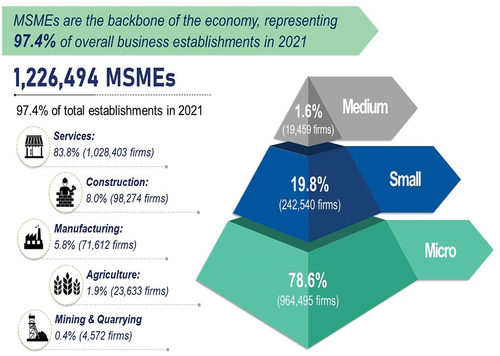
In Malaysia, it is worth emphasizing that local MSMEs made a significant contribution to Malaysia’s economy in 2021. They accounted for 37.4% of the country’s GDP, 11.7% of its total exports, 47.8% of the job opportunities and 0.1% of its total productivity as Figure .
Figure 3. Contribution of MSMEs Malaysia 2021 “DOSM (Citation2021)”.
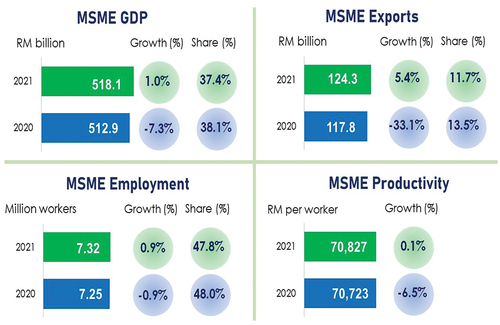
In 2021, Malaysia’s MSMEs’ GDP witnessed a growth of 1.0%, which was lower compared to the overall GDP growth rate. This trend was consistent with the previous year, as indicated by the time-series data of GDP Malaysia and MSMEs, as illustrated in Figure . Specifically, in 2020, MSMEs experienced a decline in GDP of 7.3%, highlighting the challenges faced by this sector in the face of economic uncertainties.
Figure 4. GDP, Malaysia, MSMEs and non-MSMEs 2001–2021 at constant prices- Annual percentage change “DOSM (Citation2021)”.
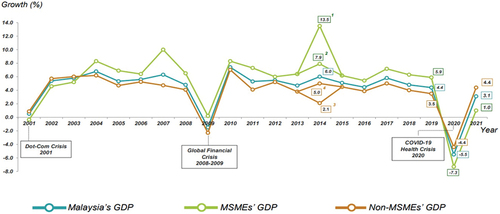
In 2021, the performance of MSMEs in contributing to Malaysia’s GDP decreased by 37.4%, amounting to RM518.1 billion in value added. This decline was observed compared to the previous year when MSMEs contributed 38.1%, as illustrated in Figure . The manufacturing and services sectors continued to play a significant role in MSMEs’ GDP activities, collectively accounting for over 80.0% of total MSMEs’ GDP. Moreover, MSMEs’ GDP in nominal terms reached RM572.6 billion in 2020, indicating growth from the previous year’s value of RM547.3 billion.
Figure 5. Value added and contribution of MSMEs’ GDP to Malaysia GDP 2015–2021 at constant 2015 prices “DOSM (Citation2021).
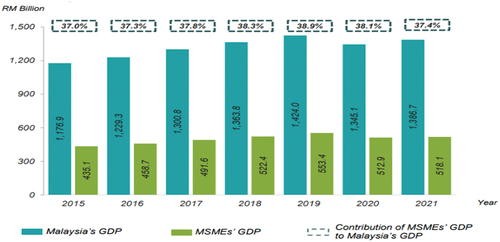
The MSMEs manufacturing sector experienced a notable rebound in value added, recording a growth rate of 8.5%. This rebound followed a decline of 2.9% in 2020, as indicated in Figure . The excellent performance in the manufacturing sector can be attributed to positive growth across all sub-sectors. Particularly, the petroleum, chemical, rubber, and plastic products sub-sector demonstrated significant increases, surging by 14.4%. Additionally, the food, beverages, and tobacco sub-sector also experienced stronger growth, reaching 4.6%, an increase from 2020 growth rate of 1.9%.
Figure 6. Annual percentage change of MSMEs’ GDP by kind of economic activity for 2019–2021 at constant 2015 prices “Department of Statistics Malaysia (Citation2021)”.

In the agriculture sector, MSMEs experienced an expansion in value added, with a growth rate of 1.9% compared to a negative growth rate of 0.7% in 2020. This positive growth was primarily driven by the livestock, rubber, oil palm and other agriculture sub-sector, which flourished with a growth rate of 2.5% in 2021. However, the fishing sub-sector remained negative this year.
On the other hand, the mining & quarrying sector witnessed a contraction in value added for MSMEs, with a decline of 3.1%. Similarly, the construction sector narrowed its decline to 4.6% from a negative growth rate of 15.4% in 2020.
The MSMEs services sector reported a lower decline of 1.2% in 2021. The decrease was affected by a 5.8% decline in the real estate, insurance, finance and business services sub-sector. However, this was offset by the rebound in performance of the food and beverages, accommodation, wholesale and retail trade sub-sector, which grew by 0.5%. Additionally, the information and communication and transportation and storage sub-sector grew by 2.9%.
The services sector remained the dominant contributor to MSMEs activities, accounting for 60.8%, followed by manufacturing at 22.3% as illustrated in Figure . Agriculture sector contributed 10.5% to MSME GDP. While construction sector and mining and quarrying sector contributed 4.8% and 0.5% respectively.
Figure 7. Percentage share of Malaysia and MSMEs’ GDP for 2021 at constant 2015 prices “DOSM (Citation2021)”.
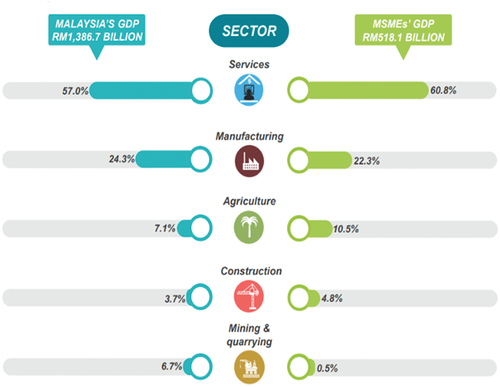
2.3. National entrepreneurship policy
On 11 July 2019, the Prime Minister of Malaysia, YAB Tun Dr. Mahathir Mohamad, launched National Entrepreneurship Policy (DKN 2030). The purpose of DKN 2030 is to develop policies that foster the growth of an entrepreneurial community that is inclusive and competitive, with a particular focus on the SME sector. The aim is to enable these enterprises to compete effectively in global markets and contribute towards the sustainable development of the social entrepreneurs and B40 group.
DKN 2030 is specifically designed to cultivate an entrepreneurial ecosystem in Malaysia, with the goal of enhancing the country’s competitiveness in the global economy. This initiative recognizes the increasing competition and challenges posed by Industry 4.0 and aims to address them effectively. Furthermore, DKN 2030 seeks to foster an entrepreneurial culture within Malaysian society.
The policy document outlines five key objectives:
Fostering a conducive environment for entrepreneurship: DKN 2030 aims to create a supportive environment that encourages entrepreneurship by implementing policies and initiatives that facilitate business growth, reduce regulatory burdens, and promote innovation and creativity.
Enhancing the competitiveness of MSMEs: The policy places a strong emphasis on improving the competitiveness of MSMEs by providing them with access to financing, markets, technology, and capacity-building programs. This objective aims to empower MSMEs to thrive in the global marketplace.
Developing high-growth and innovative enterprises: DKN 2030 recognizes the importance of nurturing high-growth and innovative enterprises to drive economic growth. The policy aims to provide these enterprises with the necessary support, including funding, mentorship, and access to research and development facilities, to accelerate their growth and success.
Empowering the B40 group and social entrepreneurs: The policy places a strong emphasis on inclusivity, aiming to empower the B40 group (bottom 40% income group) and social entrepreneurs. DKN 2030 seeks to create opportunities for these marginalized groups by providing them with access to financing, capacity-building programs, and market access, enabling them to participate actively in economic activities.
Strengthening entrepreneurship education and research: Recognizing the importance of education and research in fostering entrepreneurship, DKN 2030 aims to enhance entrepreneurship education at all levels and promote research and development activities related to entrepreneurship. This objective seeks to build a knowledgeable and skilled workforce that is equipped to contribute to the entrepreneurial ecosystem in Malaysia.
Overall, DKN 2030 sets out a comprehensive framework to develop Malaysia’s entrepreneurial ecosystem, enhance the competitiveness of MSMEs, empower marginalized groups and social entrepreneurs, and promote entrepreneurship education and research.
Therefore, it is crucial to continue striving towards the target of achieving a 25% contribution by MSMEs to Malaysia’s overall exports by 2025, as outlined in the 12th Malaysia Plan and the DKN (Malaysian Green Technology and Climate Change Corporation, Citation2023). With the advancement of technology, it is crucial for Malaysian MSMEs to adopt digital technologies in order to enhance their global competitiveness (MGTC, Citation2023). In 2021, the MGTC reported that the gross value added of technology reached RM201.1 billion, indicating a significant increase of RM37.2 billion compared to the previous year, with a growth rate of 22.7%. The next section will elaborate on the models and theories of technology adoption.
3. The models and theories of technology adoption
Technology adoption is critical to the success and competitiveness of organizations in today’s rapidly evolving digital landscape. Several theories and models have been created to understand and describe the process of technology adoption.
3.1. Theory of Reasoned Action (TRA)
The TRA was designed to understand the association in human behaviour between behaviours and attitudes by Fishbein and Ajzen (Citation1975) in Figure . Basically, it is used to predict the way an individual with pre-existing behavioural and attitudes intentions will behave. The choices individuals make regarding their behaviours are influenced by the anticipated outcomes they expect to achieve from engaging in those behaviours. Moreover, the TRA has also been used to understand communicative discourse (Rogers et al., Citation2002). The TRA was later modified and extended, leading to the development of the Reasoned Action Approach (RAA) and Theory of Planned Behaviour (TPB). The primary objective of the TRA is to gain insight into individuals’ voluntary behaviour by examining the underlying motivations that drive their actions (Doswell et al., Citation2011). TRA suggests that a person’s intention to engage in a behaviour is the primary predictor of whether or not they will actually engage in that behaviour (Glanz et al., Citation2015). In addition, the normative component also has an influence on whether the person actually performs the behaviour, as the theory suggests. According to Azjen and Madden (Citation1986), the TRA proposes that the intention to engage in a behaviour precedes the actual behaviour. The formation of behavioural intention in the TRA is based on the belief that performing a behaviour will result in a specific outcome (Colman, Citation2015). This belief is a crucial factor in shaping the individual’s intention to engage in the behaviour. Stronger intentions result in greater effort to perform the behaviour, thereby increasing the probability of actually performing the behaviour. To test and evaluate the TRA theory, 3 constraints are defined: intention stability over time, the measurement of intention, and volitional control regarding goal, context, specificity, time and action. The main drawbacks of TRA are the failure to account for the influence of habit and cognitive deliberation, the possibility of misinterpretation through survey questions and the exclusion of moral factors. Furthermore, the voluntary nature of technology usage is a critical aspect that must be considered for TRA validation.
Figure 8. Theory of Reasoned Action (TRA) “Fishbein and Ajzen (Citation1980)”.
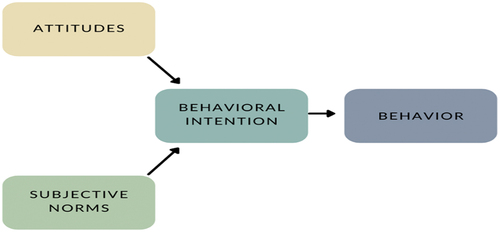
3.2. Theory of Planned Behaviour (TPB)
The TPB is based on an extension of the TRA, first introduced by Ajzen and Madden (Citation1985) in Figure . The TPB extends the TRA by adding a new variable known as Perceived Behavioural Control (PBC). Essentially, PBC depends on the availability of opportunities, skills and resources and the perceived importance of these opportunities, skills and resources in achieving the outcome (White et al., Citation2015). While both TPB and TRA assume that the person’s behavioural intention influences the person’s behaviour, TPB uses PBC to deal with the person’s behaviour that is not controlled by will. With the addition of PBC, not only are realistic limitations taken into account, but also a factor similar to self-efficacy is included (Taherdoost & Masrom, Citation2009; Taherdoost et al., Citation2012). The TPB includes three main factors that influence behavioural intention: perceived behavioural control, subjective norms, and behavioural attitudes. 2 major issues with the TPB model that have been highlighted in studies Taherdoost et al. (Citation2011) and Taherdoost et al. (Citation2011). First, a person’s attitude towards information technology (IT) may be diminished if they do not have access to a computer system (Venkatesh, Citation2000). Second, the revised TPB may be a more appropriate theoretical framework for studying the degree of voluntariness in an individual’s decision to use or not use IT at work.
Figure 9. Theory of planned behaviour (TPB) “Ajzen and Madden (Citation1985)”.
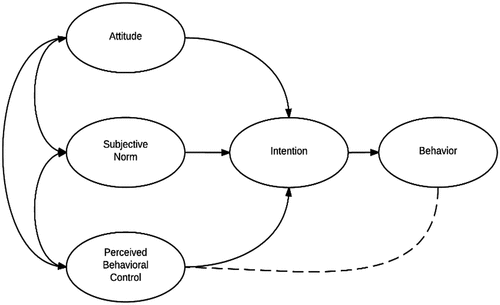
3.3. Technology Acceptance Model (TAM)
TAM is an information systems (IS) theory that models the use and acceptance of technology by users and developed by Davis (Citation1989). It was derived from the TRA. The TAM model eliminates the user’s thematic specification due to the uncertain theoretical and psychometric state of the TRA (Muk & Chung, Citation2015). Basically, TAM described the motivation of users through three contexts, namely, perceived usefulness (PU), perceived ease of use (PEU) and behaviour intention as Figure . In TAM, the two primary beliefs of PU and PEU have a substantial influence on user attitudes, which can be classified as favourable or unfavourable to the system. Occasionally, TAM may include other factors, known as external variables (Lin et al., Citation2011). Moreover, Taherdoost et al. (Citation2009) also stated that external variables are added to TAM models to improve the accuracy of predicting system usage. TAM has a limitation in that it disregards the social impact of technology adoption, thereby limiting its applicability outside of the workplace. This shortcoming has prompted the development of TAM 2 and TAM 3.
Figure 10. Technology acceptance model (TAM) “Davis (Citation1989)”.
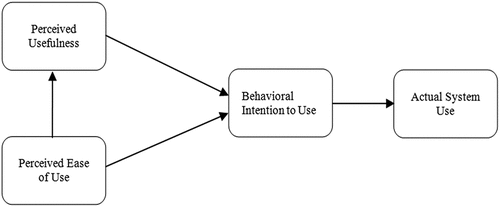
3.4. Extended TAM 2
TAM 2, developed by Venkatesh and Davis (Citation2000), retains the basic determinants of TAM, which are PU and PEU. TAM 2 extends the original TAM model by incorporating the influence of social factors on subjective norms and perceived usefulness, and the instrumental cognitive processes of output quality, job relevance and result demonstrability. TAM 2 proposes that people create mental models to evaluate the link between the use of a specific system and important work goals. These mental models are then used to form judgements about the potential benefits and usefulness of the system, specifically in terms of its impact on performance. In this way, PU is seen as a critical factor in determining technology acceptance and adoption. According to the Matching Mental Processes theory, potential users’ judgments of job relevance are typically evaluated through compatibility testing (Venkatesh & Davis, Citation2000). Thus, job relevance is primarily a person’s perception of the extent to which the goals of the system apply to the job. TAM 2 claims that both job relevance and output quality have an impact on PU. Furthermore, Venkatesh and Davis (Citation2000) propose that output quality judgments follow a typical profitability test format, where an individual is presented with a set of options that include various systems and must select the one that offers the highest output quality and is most relevant to their job. Thus, it is clear that PU is seen as the third factor influencing the demonstrability of results. Result demonstrability refers to the degree of tangibility of the results achieved through the use of a particular innovation (Moore & Benbasat, Citation1991). TAM 2 also suggests that there is a positive relationship between outcome demonstrability and PU, as illustrated in Figure .
Figure 11. TAM 2 “Venkatesh and Davis (Citation2000)”.
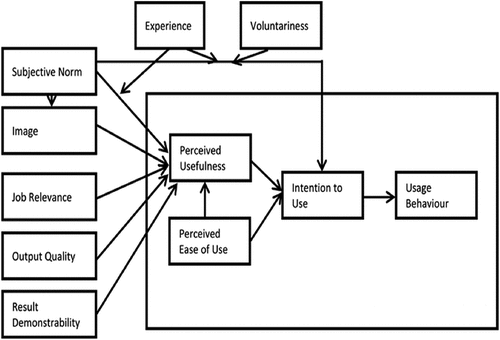
3.5. Extended TAM 3
Venkatesh and Bala (Citation2008) created an integrated model of technology acceptance, referred to TAM 3, combining TAM 2 with the model of the drivers of PEU (Venkatesh, Citation2000), as shown in Figure . The TAM 3 was developed using four typologies including system characteristics, facilitating conditions, individual differences, and social influence, which affect both PU and PEU. The TAM 3 model includes moderate effects of experience in the relations among PEU and PU, computer anxiety and PEU, and PEU and behavioural intention.
Figure 12. TAM 3 “Venkatesh and Bala (Citation2008)”.

3.6. Diffusion of Innovations (DOI)
The theory of DOI was popularised by Everett Rogers in his book “Diffusion of Innovations”, developed in 1962. It aims to explain the spread, adoption and acceptance of new ideas, products or technologies within a given population over time (Rogers, Citation2003). The DOI explores the diffusion of different innovations and introduces five factors that influence the spread of a new idea: communication channels, time, innovation, adopters and the social system. DOI has not only been applied at the individual and organizational levels, it also offers a theoretical basis to discuss adoption on a global level. Moreover, the diffusion process consists of five stages: knowledge, persuasion, decision, implementation, and confirmation. The adopter characteristics step categorizes adopters into five groups: innovators, early adopters, early majority, late majority, and laggards as shown in Figure (Rogers, Citation1962). In conclusion, although the DOI focuses on environmental aspects, organizational attributes and system characteristics, it may have less explanatory power and be less practical for predicting outcomes compared to other adoption theories.
Figure 13. DOI adopter categories “Rogers (Citation1962)”.
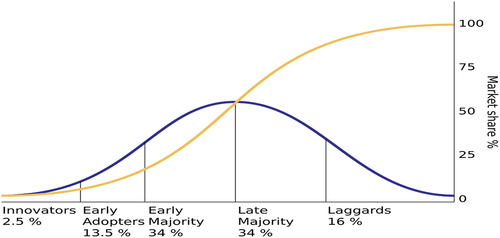
3.7. Technology—Organization–Environment Framework (TOE)
The TOE framework, initially proposed by Tornatzky and Fleischer (Citation1990) provides an explanation of technology adoption within organizations, outlines the three key factors that influence the process of implementing and adopting technological innovations, namely, the technological construct, the organizational construct, and the environmental construct as shown in Figure . TOE’s framework comprehensive structure has led many organizations and companies to use it. It has been summarized numerous applications by Oliveira and Martins (Citation2011). It is used for analysis at the organizational level (Awa et al. (Citation2017). Although the TOE framework has been extensively employed in research, it has experienced limited theoretical advancements since its initial development (Baker, Citation2012). Additionally, Baker (Citation2012) also suggest that the TOE framework is criticized for its close alignment with other technology adoption models, lacking distinctive explanations and competitive edge. As a result, there is limited impetus to change the framework.
Figure 14. TOE framework “Tornatzky and Fleischer (Citation1990)”.
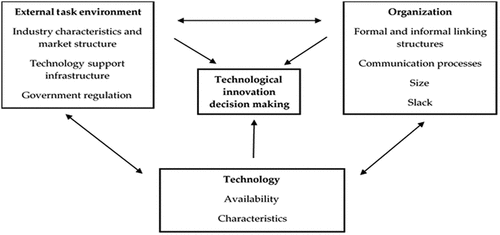
3.8. Unified Theory of Acceptance and Use of Technology (UTAUT)
The UTAUT is a technology acceptance model developed by Venkatesh et al. (Citation2003) to explain users’ intentions to use an IS and their subsequent usage behaviour. According to this theory, there are four main contexts that influence technology acceptance: 1) performance expectancy (PE), 2) effort expectancy (EE), 3) social influence (SI), and 4) facilitating conditions (FC) as illustrated in Figure . PE, EE and SI have a direct influence on usage intention and behaviour, while FC has a direct influence on user behaviour. In addition, the effects of these four main contexts on usage intention and behaviour can be moderated by factors such as voluntariness of use, experience, age and gender.
Figure 15. UTAUT “Venkatesh et al. (Citation2003)”.

3.9. Extended UTAUT 2
Venkatesh et al. (Citation2003) revised the UTAUT model and introduced UTAUT 2 in an effort to improve the theoretical framework. This modified version included three new contexts: hedonic motivation (HM), price value (PV) and habit (H). The effect of these constructs on behavioural intention and technology use was hypothesised to be moderated by individual differences such as age, experience and gender. The UTAUT 2 model was then validated through empirical research. The expansions proposed in UTAUT 2 resulted in a significant improved amount of variance explained in behavioural intention (from 56% to 74%) and technology use (from 40% to 52%) compared to UTAUT. This suggests that the inclusion of the additional constructs in UTAUT2 contributed to a more comprehensive understanding of user behaviour and intentions towards technology adoption (Figure ).
Figure 16. UTAUT 2 “Venkatesh et al. (Citation2003)”.
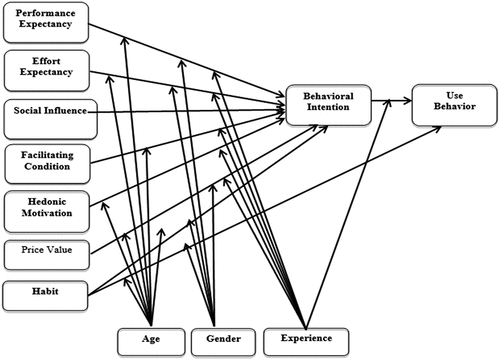
3.10. Social Cognitive Theory (SCT)
SCT is a psychological, educational, and communication theory that emphasizes the role of social experiences, interactions, and external influences in an individual’s acquisition of knowledge developed by Bandura in 1960s. According to SCT, individuals learn and develop their understanding by observing others and the social contexts in which they interact, as well as by being influenced by various forms of media. SCT was developed based on three key factors: behaviour, personal factors, and the environment as shown in Figure . These factors interact in a bi-directional manner to predict and understand both individual and group behaviour. Observing a model can also serve as a stimulus for the viewer to perform behaviour that they have already learned (Bandura, Citation1986, Citation2008).
Figure 17. SCT “Bandura (Citation1986)”.

4. The models and theories of organizational
Firm performance theory encompasses the study of a company’s performance and outcomes across various dimensions. Several theoretical frameworks have been developed to explain firm performance and provide guidance on how to enhance it.
4.1. Resource-Based View (RBV)
RBV aims to explain and predict how firms can achieve a sustainable competitive advantage by acquiring and managing valuable, rare, inimitable, and non-substitutable resources (Barney, Citation1991; Peteraf, Citation1993). These resources can be tangible or intangible assets that play a crucial role in the production and delivery of products and services (Grant, Citation1991). RBV provides valuable insights for management at the individual business level by helping to distinguish between resources that contribute to a firm’s competitive advantage and those that are of lesser value (Barney, Citation1991). It also highlights the distinction between resources that can be obtained through factor markets and those that are internally developed within the firm. For a resource to confer a competitive advantage, it must be unique to the firm, difficult for competitors to replicate, and positively impact firm performance (Barney, Citation1991).
4.2. Control Theory (CT)
The Performance Management system plays a crucial role in aligning individual performance with organizational goals. It involves the continuous process of identifying, measuring, and developing performance within an organization, ensuring that each individual’s objectives are linked to the overall mission and goals (Aguinis, Citation2011). Various strategies and approaches are utilized to simplify and enhance the performance management process. One notable approach is CT, which focuses on establishing control mechanisms between the organization and its systems. According to CT, all system actions should be in harmony with the organization’s goals and objectives (Barrows & Neely, Citation2012). This helps sustain an effective performance management system within the organization.
CT emphasizes the implementation of control mechanisms throughout an organization. These mechanisms can take various forms to achieve desired results, including:
Organizational structure: The design and arrangement of roles, responsibilities, and reporting lines within the organization.
Behavioural controls: Norms and policies that guide employee behaviour and actions within the organization.
Performance measurement mechanisms: Tools and systems used to evaluate and monitor individual and organizational performance.
These control mechanisms work together to ensure that the organization’s operations align with its goals and objectives, enabling effective performance management and achieving desired outcomes.
4.3. Agency Theory (AT)
AT, a longstanding theory in finance, explains the principal-agent relationship and has found application in various areas of corporate finance and management. It has been particularly relevant in understanding the relationship between ownership, risk, and firm performance, especially in the banking sector. Numerous empirical studies have tested and validated the theory’s applicability in different contexts, including within the Gulf Cooperation Council Countries.
The theory highlights the separation of ownership and management in firms, with shareholders playing a controlling and funding role. It addresses agency problems that arise when there is dispersed ownership and limited incentives for shareholders with small stakes to monitor managers. AT has shed light on the inner workings of firms, exploring the contractual relationships among different factors of production, each motivated by self-interest (Jensen & Meckling, Citation1976).
Additionally, AT has been extended to explain corporate behaviour, ownership structure, and management practices. It revolves around a contractual relationship between owners (principals) and managers (agents), where decision-making authority is delegated. The primary objective is to provide ongoing monitoring to mitigate agency problems that arise from the interplay between owners and managers.
4.4. Institutional Theory (IT)
According to Lincoln, IT focuses on how company structures and processes derive meaning and achieve stability, rather than solely emphasizing their effectiveness and efficiency in achieving desired outcomes, such as aligning with the company’s vision and mission. IT encompasses two main variants: the sociological variant driven by legitimacy and the economic variant. Institutions exert three types of isomorphic pressures on organizations: coercive pressures (organizations depend on the resources of others), normative pressures (organizations conform to professional standards and practices), and mimetic pressures (organizations imitate successful counterparts when uncertain about appropriate actions).
IT has been employed to explain that companies engaged in social and green initiatives are motivated not only by monetary gains but also by considerations of legitimacy and brand image (Brønn & Vidaver-Cohen, Citation2009). This implies that organizations consciously or unconsciously adopt successful managerial practices from other companies (Huang et al., Citation2010) when facing uncertainty about their future business strategies. In essence, IT highlights the influence of motivations beyond financial factors and the tendency for organizations to imitate successful practices to navigate uncertain business landscapes.
4.5. Stakeholder Theory (ST)
ST is a comprehensive theory in organizational management and business ethics that considers the impact of various constituents affected by business entities, including employees, suppliers, local communities, creditors, and others. It addresses moral and value-related aspects of managing an organization, such as corporate social responsibility, market economy, and social contract theory (Lin, Citation2018).
The stakeholder view of strategy combines elements from the RBV and market-based view while incorporating a socio-political dimension. One common version of stakeholder theory aims to identify the specific stakeholders of a company (normative theory of stakeholder identification) and examines the factors that influence how managers treat these stakeholders (descriptive theory of stakeholder salience) (Phillips, Citation2003).
ST has challenged conventional frameworks in areas like law, management, and human resources by proposing that stakeholders’ needs should be prioritized at the forefront of decision-making processes (Harrison & Colle, Citation2010). Some scholars, such as Geoffroy Murat, have even explored the application of stakeholder theory to unconventional contexts like irregular warfare (Connelley & Tripodi, Citation2012).
The essence of ST lies in organizations emphasizing a broader set of interests beyond solely pursuing shareholder wealth. It calls for considering social and environmental performance alongside financial performance. Freeman and McVea (Citation2001) emphasize that the stakeholder approach involves managing the business environment, nurturing relationships, and promoting shared interests as essential for long-term survival. Freeman (Citation2004) highlights the importance of alignment between organizational values, stakeholder expectations, and societal issues in determining a firm’s ability to effectively market its products. Additionally, Freeman (Citation1984) suggests that satisfying stakeholders’ interests can ultimately enhance firm performance.
4.6. Resource Dependency Theory (RDT)
RDT focuses on how board directors play a crucial role in providing necessary resources for the firm (Awotundun et al., Citation2011). These resources can be obtained from insiders, experts, support specialists, and influential individuals in the community. Directors leverage their expertise in specific areas to contribute specific resources such as legal advice, skills, and information. In strategic decision-making, firms apply RDT to ensure the provision and security of essential resources by establishing external networks. Effective resource management is vital for organizational functioning, performance, and survival. RDT emphasizes the importance of managing resources effectively and efficiently as a key determinant of organizational success (Van Ness et al., Citation2013). Furthermore, beyond directors’ expertise, the ability to access external networks is essential. This enables the company to tap into new markets, secure sources of finance, and gain reputation benefits. Additionally, the diversity of corporate board members is a critical factor that broadens corporate networks and improves financial performance (Pfeffer, Citation1972). RDT is also utilized by firms to reduce dependency and uncertainty through changes in organizational interdependence. Mergers and acquisitions are commonly employed strategies to minimize dependency levels (Pfeffer, Citation1987). These actions help firms reduce competition, exchange operations and expertise, and align objectives and goals in a collective manner.
5. Research methodology
Systematic literature reviews can be classified into different categories: domain-based, theory-based, method-based, and meta-analytical reviews. Domain-based reviews cover a wide range of subject areas, including business-related disciplines like management, marketing, finance, accounting, entrepreneurship, as well as non-business-related fields. Meta-analytical reviews are increasingly popular across various subjects (Paul & Feliciano-Cestero, Citation2020).
In this research, the focus is on conducting a domain-based review specifically related to the challenges faced by MSMEs in technology adoption. The researchers have utilized a longitudinal approach, reviewing a series of research papers on the subject. The methodology involves conducting a structured review by making tables. The researchers have searched for relevant papers from databases such as ScienceDirect, Scopus and Google Scholar, covering the past decade of literature. This comprehensive review aims to identify common challenges encountered by MSMEs in adopting technology as Table . By integrating the findings from the literature review and analysis, this research seeks to provide a robust foundation for understanding technology adoption in the context of micro and small businesses.
Table 1. The challenges of technology adoption among small business in 2013–2023
6. Results and discussion
After conducting a thorough literature review spanning the past decade, numerous recurring challenges have been identified concerning MSMEs’ adoption of diverse technologies, encompassing technology 4.0, social media tools, e-commerce, m-commerce, and other technological solutions as Table .
Table 2. Recurring Challenges in MSMEs' Adoption of Technologies
Based on the analysis of the challenges, the significant obstacles for micro and small businesses owners and managers are:
6.1. Challenges of adoption
Adoption challenges in technology implementation are closely linked to employee attitudes, budget limitations, and internal organizational characteristics. Resistance to change, particularly among older employees who prefer routine practices, can hinder the adoption process. Lewin’s change management model has also highlighted the reluctance of employees towards new changes (Kumar & Ayedee, Citation2019a; Kumar et al., Citation2020). Financial constraints at the organizational level also pose challenges to adoption. Moreover, the willingness of internal executives to embrace new technology, encourage creativity, and foster innovation, as well as concerns about data secrecy, are additional factors that influence the technology adoption process.
6.2. Lack of technical and efficiency
A significant challenge in technology adoption is the insufficient technical skills and efficiency of employees, managers, and owners. Many lack adequate knowledge and training in technology adoption, with some organizations even lagging behind in adopting basic technologies like social media tools (referred to as technology 2.0). As digital marketing becomes a crucial marketing trend, micro and small businesses owners require training to improve their technical proficiency and meet the expectations of the rapidly changing business landscape.
6.3. Lack of organizational support
For micro and small businesses to fully transition to new technology, corporate assistance is crucial. Corporate sponsorship can be evaluated based on various aspects. Organizations should provide financial support, training, adequate time for the switch over, expert guidance, supportive infrastructure, and a well-planned change management process to facilitate effective implementation.
6.4. Less government supports
Governments play a crucial role in promoting technology adoption at the organizational level. Government-funded training programs can assist micro and small businesses owners, managers, and employees in adopting technology. Additionally, special schemes and support from the government can contribute to successful adoption. Furthermore, governmental assistance can facilitate the establishment of necessary technological infrastructure for technology adoption.
6.5. Technology and infrastructure costs
While technology adoption can eventually lead micro and small businesses to economies of scale and cost reduction, there are initial hurdles to overcome. Researchers have highlighted the high initial cost of technology implementation and the challenges in setting up the required infrastructure. Micro and small businesses owners and managers must address these challenges before considering the adoption of any technology at the organizational level.
6.6. Lack of safety or security
Another important challenge in technology adoption is the concern about safety and security. Micro and small businesses may be wary of potential risks and vulnerabilities associated with adopting new technologies. They may fear data breaches, cyberattacks, and unauthorized access to sensitive information. Ensuring robust cybersecurity measures and data protection protocols becomes crucial to address these security concerns.
6.7. Internet and obsolete technologies
In some cases, micro and small businesses may face challenges related to internet connectivity and the use of outdated technologies. Limited access to high-speed and reliable internet can hinder the effective implementation of technology solutions. Additionally, using obsolete technologies may limit their ability to fully leverage the benefits of advanced technologies. Upgrading to more modern and efficient systems becomes essential to overcome these challenges and remain competitive in the digital era.
7. Conclusion
MSME are a critical component of the Malaysian economy, contributing significantly to the country’s GDP and exports (Salim et al., Citation2022). However, these enterprises face numerous challenges that impact their competitiveness, including limited access to financing, low productivity, and inadequate technology adoption (Andalib & Darun, Citation2018; Hoque et al., Citation2017).
To address these challenges, several theories of technology adoption have been proposed, including the Technology Acceptance Model (TAM), Theory of Reasoned Action (TRA), Diffusion of Innovation (DOI), Unified Theory of Acceptance and Use of Technology (UTAUT), Social Cognitive Theory (SCT), Technology-Organization-Environment (TOE), and Theory of Planned Behaviour (TPB). These theories provide a framework for understanding how MSMEs can effectively adopt technology and improve their performance. Furthermore, several theories of organizational have been proposed including Resource-Based View (RBV), Control Theory (CT), Agency Theory (AT), Institutional Theory (IT), Stakeholder Theory (ST), and Resource Dependency Theory (RDT), offer valuable insights into the internal dynamics and external influences that shape technology adoption within MSMEs in Malaysia.
The DOI model emphasizes the importance of system characteristics, organizational attributes, and environmental factors in the technology adoption process. In contrast, the TOE model emphasizes the role of technological, organizational, and environmental contexts in technology adoption. The UTAUT model adds three new constructs, including HM, PV, and H, to the existing constructs of PE, EE, SI, and enabling conditions. Finally, SCT posits that individuals’ behaviour and knowledge acquisition can be influenced by observing others in social interactions, experiences, and outside media influences.
In Malaysia, the government has set ambitious targets for MSMEs’ contribution to the country’s GDP and exports (Salim et al., Citation2022). However, achieving these targets will require a concerted effort to improve MSMEs’ access to financing, increase productivity, and encourage technology adoption. The adoption of digital technology can help MSMEs improve their competitiveness and enhance their ability to compete in the global market.
8. Recommendations and future research
To address the phenomenon of low technology adoption among MSMEs in Malaysia, further research is needed to explore and understand the specific barriers and challenges that hinder their uptake of digital technology as follow:
8.1. Identify barriers to technology adoption
Conduct qualitative research to identify the specific barriers and challenges faced by MSMEs in adopting digital technology. This could involve interviews, surveys, and focus groups with MSME owners, managers, and employees to gain insights into their perceptions, concerns, and constraints related to technology adoption.
8.2. Assess the effectiveness of technology adoption theories
Evaluate the applicability and effectiveness of various technology adoption theories, such as the Technology Acceptance Model (TAM), Theory of Reasoned Action (TRA), Diffusion of Innovation (DOI), Unified Theory of Acceptance and Use of Technology (UTAUT), Social Cognitive Theory (SCT), Technology-Organization-Environment (TOE), and Theory of Planned Behaviour (TPB), in the context of MSMEs in Malaysia. This research could help identify which theories are most relevant and useful for understanding technology adoption among MSMEs.
8.3. Examine government policies and support
Investigate the role of government policies and support in promoting technology adoption among MSMEs. Assess the effectiveness of existing initiatives and identify potential areas for improvement to better facilitate technology adoption and integration into MSME operations.
8.4. Study successful technology adoption cases
Conduct case studies of MSMEs that have successfully adopted and integrated digital technology into their business processes. Identify the strategies, best practices, and lessons learned from these successful cases that can be replicated or adapted by other MSMEs.
8.5. Explore capacity building and training needs
Examine the training and capacity-building needs of MSMEs to enhance their technical skills and knowledge related to technology adoption. Investigate the availability and effectiveness of existing training programs and identify gaps and opportunities for skill development.
8.6. Analyze the role of industry associations
Investigate the role of industry associations and networks in promoting technology adoption among MSMEs. Assess how these associations can facilitate knowledge sharing, collaboration, and technology adoption support among their members.
By conducting research in these areas, policymakers, industry stakeholders, and MSMEs themselves can gain valuable insights to devise targeted strategies and interventions to enhance technology adoption rates, thus bolstering the competitiveness and sustainability of Malaysian MSMEs in the global market.
9. Implications for MSMEs
MSMEs are a critical component of the Asian business landscape, making significant contributions to economic development. However, many MSMEs face challenges in adopting technology, and limited knowledge becomes a barrier for owners and managers. This study aims to provide guidance to MSME managers and owners by identifying initial level challenges in technology adoption.
Amid the COVID-19 pandemic, the need for technology adoption has become even more relevant as many MSMEs have experienced financial losses. Embracing technology enables remote work and maintains productivity, while digital marketing reduces costs compared to traditional methods. With tough competition both within and outside Asian countries, technology adoption becomes crucial for MSMEs to reach the level of developed countries and stay competitive.
MSMEs play a catalytic role in increasing market competition and enhancing economies. Governments in Asian countries should play a central role in supporting MSMEs in terms of cost and training challenges. Loan schemes and programs to improve digital literacy can aid MSMEs in technology adoption. Managers need to motivate employees and address their adoption challenges, fostering a positive and confident environment for technology integration.
By leveraging this study, MSMEs can better assess challenges, find solutions, and effectively communicate with employees to drive successful technology adoption. Governments and managers should collaborate to create an enabling environment, empowering MSMEs to thrive and contribute significantly to the growth of Asian economies.
Disclosure statement
No potential conflict of interest was reported by the author(s).
Additional information
Notes on contributors
Mei Kay Loo
Loo Mei Kay (ORCID: 0000-0001-9715-488X) is a PhD student in the School of Business and Economics at Universiti Putra Malaysia ([email protected]/ [email protected]). Her primary interests are social media adoption, technology adoption, MSMEs, and business performance.
Sridar Ramachandran
Sridar Ramachandran (ORCID: 0000-0002-4054-7794) is a professor in the School of Business and Economics at Universiti Putra Malaysia ([email protected]). His research interests focus on sustainable tourism, marketing, and research philosophy.
Raja Nerina Raja Yusof
Raja Nerina Raja Yusof (ORCID: 0000-0002-6768-2865) is an Associate Professor in the School of Business and Economics at Universiti Putra Malaysia ([email protected]). Her research interests are international business management, SMEs, marketing and entrepreneurship.
References
- Abd Aziz, N. A., Hanafiah, M. H., Abd Hamid, H., & Isa, R. M. (2019). Survival of franchising firm: A study of self-service laundry franchisor. International Journal of Entrepreneurship, 23, 1–32. https://www.researchgate.net/publication/338263598_SURVIVAL_OF_FRANCHISING_FIRM_A_STUDY_OF_SELF-SERVICE_LAUNDRY_FRANCHISOR
- Abd Aziz, N. A., Hanafiah, M. H., Hussin, N. S. N., Abd Latif, M. N., & Aziz, Z. A. (2021). Franchising relationship: Malaysian franchisees’ perspectives. In The importance of new technologies and entrepreneurship in business development: In the Context of Economic Diversity in developing countries (pp. 317–335). Springer International Publishing. https://doi.org/10.1007/978-3-030-69221-6_23
- Abd Aziz, N. A., Ramdan, M. R., Nik Hussin, N. S., Abdul Aziz, Z., Osman, J., & Hasbollah, H. R. (2021). The Determinants of global expansion: A study on food and beverage franchisors in Malaysia. Sustainability, 13(18), 10328. https://doi.org/10.3390/su131810328
- Abdul Halim, H., Ahmad, N. H., Geare, A., & Thurasamy, R. (2018). Innovation culture in SMEs: The importance of organizational culture, organizational learning and market orientation. Entrepreneurship Research Journal, 9(3), 1–14. https://doi.org/10.1515/erj-2017-0014
- Abu, A. F., & Margaret, L. S. (2022). The digitalization of micro, small, and medium-sized enterprises (MSMEs): An institutional theory perspective. Journal of Small Business Management, 60(6), 1288–1313. https://doi.org/10.1080/00472778.2020.1745536
- Afifah, A. N., Najib, M., & Sarma, M. (2018). Digital marketing adoption and the influences towards business successes of MSMEs creative sector in Indonesia and Malaysia. Journal of Applied Management (JAM), 16(3), 377–386. https://doi.org/10.21776/ub.jam.2018.016.03.01
- Aguinis, H. (2011). Performance Management. Heriot-Watt University. Retrieved from https://www.ebsglobal.net/EBS/media/EBS/PDFs/Performance-Management-Course-Taster.pdf
- Ajzen, I., & Madden, T. (1985). Prediction of goal-directed behavior: Attitudes, intentions, and perceived behavioral control. Journal of Experimental Social Psychology, 22(5), 453–474.
- Al-Azzama, M. K. A., Al-Alwanb, M. A. M., Alqahtanic, M. M., Al-Hawaryd, S. I. S., & Alserhand, A. F. (2023). Determinants of behavioral intention to use big data analytics (BDA) on the information and communication technologies (ICT) SMEs in Jordan. Decision Science Letters, 12(2023), 605–616. https://doi.org/10.5267/j.dsl.2023.4.004
- Ali, Q. (2021). Examining the factors affecting SME performance: The mediating role of social media adoption. Sustainability, 13(1), 75. https://doi.org/10.3390/su13010075
- Aligarh, F., Sutopo, B., & Widarjo, W. (2023). The antecedents of cloud computing adoption and its consequences for MSMEs’ performance: A model based on the technology-organization-environment (TOE) framework. Cogent Business & Management, Taylor & Francis Journals, 10(2), 190–222.
- AlSharji, A., Ahmad, S., & Bakar, A. (2018). Understanding social media adoption in SMEs. Journal of Entrepreneurship in Emerging Economies, 10(2), 302–328. https://doi.org/10.1108/JEEE-08-2017-0058
- Amornkitvikai, Y., Tham, S. Y., Harvie, C., & Buachoom, W. W. (2022). Barriers and factors affecting the E-Commerce Sustainability of Thai micro-, small- and medium-sized enterprises (MSMEs). Sustainability, 14(14), 8476. https://doi.org/10.3390/su14148476
- Ananda, M. O., Annuar, S. N. S., Adam, A. A., & Sharkawi, S. (2023). The pivotal role of cashless system adoption among micro, small, and medium enterprises (MSMEs) in Malaysia: The challenges and opportunities. South East Asia Journal of Contemporary Business, Economics and Law, 28(3), 35–43.
- Andalib, T. W., & Darun, M. R. (2018). An HRM model for manufacturing companies of Bangladesh mapping employee rights’ protocols and grievance management system. Indian Journal of Science and Technology, 11(17), 1–13. https://doi.org/10.17485/ijst/2018/v11i17/121429
- Anggadini, S. D., Luckyardi, S., & Surtikanti, S. (2023). Development of micro small-medium business in Asian countries (Indonesia, Malaysia, Philippines and Thailand): A comparison in accounting behavior. Journal of Eastern European and Central Asian Research (JEECAR), 10(3), 487–497. https://doi.org/10.15549/jeecar.v10i3.1300
- Awa, H., Ojiabo, O., & Emecheta, B. (2015). Integrating TAM, TPB and TOE frameworks and expanding their characteristic constructs for e-commerce adoption by SMEs. Journal of Science and Technology Policy Management, 6(1), 76–94. https://doi.org/10.1108/JSTPM-04-2014-0012
- Awa, H. O., Ojiabo, U. O., & Orokor, L. E. (2017). Integrated technology-organization-environment (T-O-E) taxonomies for technology adoption. Journal of Enterprise Information Management, 30(6), 893–921. https://doi.org/10.1108/JEIM-03-2016-0079
- Awotundun, D. A., Kehinde, J. S., & Somoye, R. O. C. (2011). Corporate governance and stakeholders interest: A case of Nigerian banks. International Journal of Business & Management, 6(10). https://doi.org/10.5539/ijbm.v6n10p102
- Azjen, I., & Madden, T. (1986). Prediction of goal-directed behavior: Attitudes, intentions, and perceived behavioral control. Journal of Experimental Social Psychology, 22(5), 453–474. https://doi.org/10.1016/0022-1031(86)90045-4
- Azman, N. H. N., Zabri, M. Z. M., Masron, T. A., & Malim, N. A. K. (2020). The adoption of ar-rahnu and financial wellbeing of micro-entrepreneurs in Malaysia. The International Journal of Academic Research in Business & Social Sciences, 10(6), 36–53. https://doi.org/10.6007/IJARBSS/v10-i6/7259
- Baker, J. (2012). The technology–organization–environment framework. In Y. K. Dwivedi, M. R. Wade, & S. L. Schneberger (Eds.), Information systems theory: Explaining and predicting our digital society, vol. 1. integrated series in information systems (Vol. 28, pp. 231–245). Springer.
- Bandura, A. (1986). Social foundations of thought and action: A social cognitive theory. Prentice-Hall.
- Bandura, A. (2008). Social cognitive theory of mass communication. In J. Bryant & M. B. Oliver (Eds.), Media effects: Advances in theory and research (pp. 94–124). Routledge.
- Barney, J. B. (1991). Firm resources and sustained competitive advantage. Journal of Management, 17(1), 99–120. https://doi.org/10.1177/014920639101700108
- Barroga, K. D., Wabina, V. E. R., & Sales, A. C. (2021). Level of awareness of Smart manufacturing technologies and its nexus to adoption among micro, small, and medium enterprises in the Philippines. Philippine Journal of Science, 150(6A), 1593–1606. https://doi.org/10.56899/150.6A.20
- Barrows, E., & Neely, A. (2012). Managing performance in turbulent times: Analytics and insight – ed, Barrows, Andy Neely. John Wiley & Son Inc. Retrieved from https://books.google.co.in/books?id=-xUSnCgLF9sC&pg=PT205&dq=control+theory+of+performance+management&hl=en&sa=X&ved=0ahUKEwjj3r2JnL7QAhUhTY8KHU1HC_8Q6AEISTAG#v=onepage&q=controltheoryofpeformancemanagement&f=false
- Bharathi, S., & Mandal, T. (2015). Prioritising and ranking critical factors for sustainable cloud ERP adoption in SMEs. International Journal of Automation and Logistics, 1(3), 294–316. https://doi.org/10.1504/IJAL.2015.071723
- Brønn, P. S., & Vidaver-Cohen, D. (2009). Corporate motives for social initiative: Legitimacy, sustainability, or the bottom line?. Journal of Business Ethics, 87(2), 253–271.
- Camisón, C., & Villar-López, A. (2014). Organizational innovation as an enabler of technological innovation capabilities and firm performance. Journal of Business Research, 67(1), 2891–2902. https://doi.org/10.1016/j.jbusres.2012.06.004
- Chang, S. C. H., & M, L. (2021). Evaluating Industry 4.0 technology application in SMEs: Using a hybrid MCDM approach. Mathematics, 9(4), 414. https://doi.org/10.3390/math9040414
- Charoennan, W., Kowathanakul, S., & Chatbhumiphong, B. (2022). Determinants and outcomes of crisis Management among micro, small and medium-sized Enterprise (MSME) entrepreneurs in Thailand during COVID-19 pandemic. Retrieved from http://www.jba.tbs.tu.ac.th/files/Jba175/Article/JBA175WanSuBhud.pdf
- Chatzoglou, P., & Chatzoudes, D. (2016). Factors affecting e-business adoption in SMEs: An empirical research. Journal of Enterprise Information Management, 29(3), 327–358. https://doi.org/10.1108/JEIM-03-2014-0033
- Chen, J. S., Tsou, H. T., & Huang, A. Y.-H. (2009). Service delivery innovation: Antecedents and impact on firm performance. Journal of Service Research, 12(1), 36–55. https://doi.org/10.1177/1094670509338619
- Coleman, S., Göb, R., Manco, G., Pievatolo, A., Tort‐Martorell, X., & Reis, M. S. (2016). How can SMEs benefit from big data? Challenges and a path forward. Quality and Reliability Engineering International, 32(6), 2151–2164. https://doi.org/10.1002/qre.2008
- Colman, A. (2015). Theory of Reasoned Action. A Dictionary of Psychology.
- Connelley, & Tripodi. (2012). Aspects of leadership, ethics, law and spirituality. Marines Corps University Press.
- Dahnil, M., Marzuki, K., Langgat, J., & Fabeil, N. (2014). Factors influencing SMEs adoption of social media marketing. Procedia - Social & Behavioral Sciences, 148, 119–126. https://doi.org/10.1016/j.sbspro.2014.07.025
- Davis, F. D. (1989). Perceived usefulness, perceived ease of use and user acceptance of information technology. MIS Quarterly, 13(3), 319–340. https://doi.org/10.2307/249008
- Department of Statistic Malaysia. (2022) . Interactive Malaysia statistical business register (i-MSBR). Department of Statistics Malaysia.
- Department of Statistics Malaysia. (2021) . Performance of small and medium enterprises (SMEs) 2021.
- Department of Statistics Malaysia DOSM. (2021). Retrieved from (accessed on 27 July 2022) https://www.dosm.gov.my/portal-main/release-content/micro-small-&-medium-enterprises-msmes-performance-2021
- Doswell, W., Braxter, B., Cha, E., & Kim, K. (2011). Testing the theory of reasoned action in Explaining Sexual behavior among African American Young Teen Girls. Journal of Pediatric Nursing, 26(6), e45–e54. https://doi.org/10.1016/j.pedn.2011.03.007
- Efrat, K., Hughes, P., Nemkova, E., Souchon, A. L., & Sy-Changco, J. (2018). Leveraging of dynamic export capabilities for competitive advantage and performance consequences: Evidence from China. Journal of Business Research, 84, 114–124. https://doi.org/10.1016/j.jbusres.2017.11.018
- Elissa, D. L., Hamid, N. A., Rizkalla, N., Purnamaningsih, P., & Urus, S. B. T. (2022). The Effect of Financial Literacy, cost of technology adoption, technology perceived usefulness, and government support on MSMEs' business resilience. GATR Journals gjbssr620, Global Academy of Training and Research (GATR) Enterprise, 3(3). https://doi.org/10.35609/gjbssr.2022.10.3
- Fauzi, A. A., & Sheng, M. L. (2022). The digitalization of micro, small, and medium-sized enterprises (MSMEs): An institutional theory perspective. Journal of Small Business Management, Taylor & Francis Journals, 60(6), 1288–1313.
- Fishbein, M., & Ajzen, I. (1975). Belief, attitude, intention, and behavior: An introduction to theory and research. Addison-Wesley.
- Fishbein, M., & Ajzen, I. (1980). Predicting and understanding consumer behavior: Attitude-behavior correspondence. In I. Ajzen & M. Fishbein (Eds.), Understanding attitudes and predicting social behavior (pp. 148–172). Prentice Hall.
- Frank, A., Sutopo, B., & Widarjo, W. (2023). The antecedents of cloud computing adoption and its consequences for MSMEs’ performance: A model based on the technology-organization-environment (TOE) framework. Cogent Business & Management, 10(2), 2220190. https://doi.org/10.1080/23311975.2023.2220190
- Freeman, E. R. (1984). Strategic Management: A stakeholder approach. Pitman.
- Freeman, R. E. (2004). The stakeholder approach revisited. Zeitschrift für Wirtschafts- und Unternehmensethik, 5(3), 228–241.
- Freeman, R. E., & McVea, J. (2001). A stakeholder approach to strategic management. Darden Business School Working Paper No. 01-02.
- Gandhi, A., Nurcahyo, R., & Gabriel, D. S. (2021). Identification of challenges and benefits of product certification on micro, small, and medium enterprises (MSMEs) in Indonesia. Proceedings of the 11th Annual International Conference on Industrial Engineering and Operations Management Singapore, March 7-11.
- Glanz, K., Rimer, B. K., & Viswanath, K. (2015). Theory of reasoned action, theory of planned behavior, and the integrated behavioral model. In K. Glanz, B. K. Rimer, & K. Viswanath (Eds.), Health behavior: Theory, research, and practice (5th ed.) (pp. 95–124). Jossey-Bass/Wiley.
- Gomez-Mejia, L. R., Balkin, D. B., & Cardy, R. L. (2021). Managing human resources (9th ed.). Pearson.
- Grant, R. M. (1991). The resource-based theory of competitive advantage: Implications for strategy formulation. California Management Review, 33(3), 114–135.
- Hanifah, H., Halim, H. A., Ahmad, N. H., & Vafaei-Zadeh, A. (2019). Can internal factors improve innovation performance via innovation culture in SMEs? Benchmarking: An International Journal, 27(1), 382–405. https://doi.org/10.1108/BIJ-06-2018-0174
- Harrison, W. P., & Colle, D. (2010). Stakeholder theory, state of the art. Cambridge University Press.
- Hasbolah, F., Rosli, M. H., Hamzah, H., Omar, S. A. I., & Bhuiyan, A. B. (2021). The digital accounting entrepreneurship competency for sustainable performance of rural micro, small, and medium enterprises (MSMEs): An empirical review. International Journal of Small and Medium Enterprises, 4(1), 12–25.
- Hoque, A. S. M. M., Awang, Z., & Salam, S. (2017). The effects of relationship marketing on firm performance: Small and medium enterprises (SMEs) in Bangladesh. In Proceedings of the 1st International Conference on Business and Management (ICBM-2017), BRAC Business School (BBS), BRAC University, Dhaka, Bangladesh.
- Huang, L., Klassen, R. D., & Plambeck, E. L. (2010). When does extended producer responsibility reduce environmental impacts?. California Management Review, 52(3), 6–31.
- Islami, N. N., Wahyuni, S., & Puji, R. P. N. (2021). Digital Literation of micro, small and medium enterprises (MSMEs) in Jember District. 3rd International Conference on Environmental Geography and Geography Education.
- Jaganathan, M., Ahmad, S., Ishak, K. A., Nafi, S. N. M., & Uthamaputhran, L. (2018). Determinants for ICT adoption and problems: Evidence from rural-based small and medium enterprises in Malaysia. International Journal of Entrepreneurship, 22(4), 1–13.
- Jalil, S. W., Haris, N., Putit, L., & Shuib, A. R. A. (2022). An exploration into the Drivers of social media usage among MSME handicraft entrepreneurs. Journal of International Business, Economics and Entrepreneurship, 7(1), 53–60.
- Jamalut, Y., Rahim, M. F. A., & Ong, J. W. (2022). A framework on intention to adopt internet of things among MSMEs in farming. Advances in Economics, Business and Management Research. Proceedings of the International Conference on Technology and Innovation Management (ICTIM 2022), 321–332.
- Jensen, M. C., & Meckling, W. H. (1976). Theory of the firm: Managerial behavior, agency costs and ownership structure. Journal of Financial Economics, 3(4), 350–360. https://doi.org/10.1016/0304-405X(76)90026-X
- Kaasa, A. (2016). Culture as a possible factor of innovation: Evidence from the European Union and neighboring countries. In Re-Thinking Diversity (pp. 83–107). Springer. https://doi.org/10.1007/978-3-658-11502-9_5
- Kabanda, S., & Brown, I. (2017). A structuration analysis of small and medium Enterprise (SME) adoption of E-Commerce: The case of Tanzania. Telematics and Informatics, 34(4), 118–132. https://doi.org/10.1016/j.tele.2017.01.002
- Kilay, A. L., Simamora, B. H., & Putra, D. P. (2022). The influence of E-Payment and E-Commerce services on supply chain performance: Implications of Open innovation and solutions for the digitalization of micro, small, and medium enterprises (MSMEs) in Indonesia. Journal of Open Innovation: Technology, Market, and Complexity, 8(3), 119. https://doi.org/10.3390/joitmc8030119
- Kumar, R. (2018). Research methodology: A step-by-step Guide for beginners (5th ed.). SAGE Publications.
- Kumar, A., & Ayedee, N. (2018). Social media tools for business growth of SMEs. Journal of Management, 5(3), 137–142.
- Kumar, A., & Ayedee, N. (2019a). Strategic HRM practices to deal with gender diversity problems in organizations. Journal of Strategic Human Resource Management, 8(3).
- Kumar, A., & Ayedee, N. (2019b). Sustainable development in SMEs through social media channels. International Journal of Management, Technology, and Engineering, 9(6), 1066–1075.
- Kumar, A., & Ayedee, N. (2021). Technology adoption: A solution for SMEs to overcome problems during COVID-19. Academy of Marketing Studies Journal, 25(1), 1–16.
- Kumar, A., Syed, D. A. A., & Pandey, D. A. (2020). How adoption of online resources can help Indian SMEs in improving performance during COVID-19 pandemic. Test Engineering and Management, 83, 3394–3400. https://ssrn.com/abstract=3716696
- Kumar, V., Verma, P., Mittal, A., Panduro, J. A. T., Singh, S., Paliwal, M., & Sharma, N. K. (2022, June 8). Adoption of ICTs as an emergent business strategy during and following COVID-19 crisis: Evidence from Indian MSMEs. Benchmarking: An International Journal, 30(6), 1850–1883. https://doi.org/10.1108/BIJ-11-2021-0685
- Kurniawati, E., & Idris, H., & Osman, S. (2021). Digital transformation of MSMEs in Indonesia during the pandemic. Entrepreneurship & Sustainability Issues, 9(2), 316–331. https://doi.org/10.9770/jesi.2021.9.2(21)
- Laitinen, E. K. (2002). A dynamic performance measurement system: Evidence from small Finnish technology companies. Scandinavian Journal of Management, 18(1), 65–99. https://doi.org/10.1016/S0956-5221(00)00021-X
- Lashitew, A. A. (2023). When businesses go digital: The role of CEO attributes in technology adoption and utilization during the COVID-19 pandemic. Technological Forecasting & Social Change, 189, 122324. https://doi.org/10.1016/j.techfore.2023.122324
- Lee, K., Woo, H.-G., & Joshi, K. (2016). Pro-innovation culture, ambidexterity and new product development performance: Polynomial regression and response surface analysis. European Management Journal, 35(2), 249–260. https://doi.org/10.1016/j.emj.2016.05.002
- Lewandowski, J., Salako, A., & Garcia-Perez, A. (2013). SaaS enterprise resource planning systems: Challenges of their adoption in SMEs.
- Lin, T. C. W. (2018, December 1). Incorporating social activism. 98 Boston University Law Review 1535.
- Lin, F., Fofanah, S. S., & Liang, D. (2011). Assessing citizen adoption of e-government initiatives in Gambia: A validation of the technology acceptance model in information systems success. Government Information Quarterly, 28(2), 271–279. https://doi.org/10.1016/j.giq.2010.09.004
- Lin, M. S., Sharma, A., Pan, B., & Quadri-Felitti, D. (2023). Information asymmetry in the innovation adoption decision of tourism and hospitality SMEs in emerging markets: A mixed-method analysis. Tourism Management, 99, 104793. https://doi.org/10.1016/j.tourman.2023.104793
- Maisiri. (2021). Factors that inhibit sustainable adoption of Industry 4.0 in the South African manufacturing Industry. Sustainability, 13(3), 1013. https://doi.org/10.3390/su13031013
- Malaysian Green Technology and Climate Change Corporation. (2023). Retrieved from https://www.mgtc.gov.my/2023
- Martini, M., Setiawan, D., Tanding Suryandari, R., Khresna Brahmana, R., & Asrihapsari, A. (2023). Determinants of digital innovation in micro and small industries. Economies, 11(6), 172. https://doi.org/10.3390/economies11060172
- MASTIC. (2019). National Survey of Innovation. Malaysian Science and Technology Information Centre.
- Matias, J. B., & Hernandez, A. A. (2019). Cloud computing adoption intention by MSMEs in the Philippines. Global Business Review, 22(3), 1–22. https://doi.org/10.1177/0972150918818262
- Mba, O., & Cletus, I. (2014). Issues, challenges and prospects of small and medium scale enterprises (SMEs) in port-Harcourt city, Nigeria. European Journal of Sustainable Development, 3(1), 101–114. https://doi.org/10.14207/ejsd.2014.v3n1p101
- Mohanty, E., & Mishra, A. J. (2020). Understanding the gendered nature of developing country MSMES’ access, adoption and use of information and communication technologies for development (ICT4D). International Journal of Gender and Entrepreneurship, 12(3), 273–295. https://doi.org/10.1108/IJGE-07-2019-0117
- Moore, G. C., & Benbasat, I. (1991). Development of an instrument to measure the perceptions of adopting an information technology innovation. Information Systems Research, 2(3), 192–222. https://doi.org/10.1287/isre.2.3.192
- Muk, A., & Chung, C. (2015). Applying the technology acceptance model in a two-country study of SMS advertising. Journal of Business Research, 68(1), 1–6. https://doi.org/10.1016/j.jbusres.2014.06.001
- Nasution, M. R. (2021). Entrepreneurial orientation, knowledge management, dynamic capabilities towards e-commerce adoption of SMEs in Indonesia. Journal of Science and Technology Policy Management, 12(2), 256–282. https://doi.org/10.1108/JSTPM-03-2020-0060
- Nurqamarani, A. S., Priyanto, A., & Fadilla, S. (2022). Technology adoption strategy of social media in micro small medium enterprises. Research Journal of Accounting and Business Management (RJABM), 14(1), 139–150. https://doi.org/10.31293/rjabm.v6i2.6633
- Oliveira, T., & Martins, M. F. (2011). Literature review of information technology adoption models at the firm level. Electronic Journal Information Systems Evaluation, 14(1), 110–121.
- Parvand, S., & Rasiah, R. (2022). Adoption of advanced technologies in Palm Oil Milling firms in Malaysia: The role of technology attributes, and environmental and organizational factors. Sustainability, 14(1), 260. https://doi.org/10.3390/su14010260
- Paul, J., & Feliciano-Cestero, M. (2020). Five decades of research on foreign direct investment by MNEs: An overview and research agenda. Journal of Business Research, 124, 800–812. https://doi.org/10.1016/j.jbusres.2020.04.017
- Peteraf, M. A. (1993). The cornerstones of competitive advantage: A resource‐based view. Strategic Management Journal, 14(3), 179–191. https://doi.org/10.1002/smj.4250140303
- Pfeffer, J. (1972). Merger as a response to organizational interdependence. Administrative Science Quarterly, 17(2), 218–228. https://doi.org/10.2307/2393956
- Pfeffer, J. (1987). A resource dependence perspective on inter-corporate relations. In M. S. Mizruchi & M. Schwartz (Eds.), Inter-corporate relations: The structural analysis of business (pp. 25–55). Cambridge University Press.
- Phillips, R. (2003). ISBN 978-1576752685. Stakeholder theory and organizational ethics. Berrett-Koehler Publishers. 978-1576752685.
- Prause, M. (2019). Challenges of industry 4.0 technology adoption for SMEs: The case of Japan. Sustainability, 11(20), 5807. https://doi.org/10.3390/su11205807
- Rashida, N. A., Ibrahim, N. M., Hasim, N., & Abidin, M. Z. (2022). MSME’s sustainability during the COVID-19 pandemic: The roles of Islamic crowdfunding, financial literacy and technology adoption. Journal of Emerging Economies and Islamic Research, 10(2), 74–89. https://doi.org/10.24191/jeeir.v10i2.16559
- Rogers, E. (2003). Diffusion of innovations (5th ed.). ISBN 978-0-7432-5823-4. Simon and Schuster.
- Rogers, E. M. (1962). Diffusion of innovations (1st ed.). Free Press of Glencoe.
- Rogers, G. M., Archibald, M., Morrison, D., Wilsdon, A., Wells, E., Hoppe, M., Deborah, N., & Murowchick, E. (2002). Teen sexual behavior: Applicability of the theory of reasoned action. Journal of Marriage & Family, 64(4), 885–897.
- Salim, M. N., Marlapa, E., Ismail, S., Rahman, N. H. A., Hussin, H., Susilastuti, D., & Murti, W. (2022). Determinants of MSMEs growth and its impact on income and unemployment: Cases of Indonesia and Malaysia. International Journal of Academic Research in Economics and Management and Sciences, 11(1), 223–239. https://doi.org/10.6007/IJAREMS/v11-i1/12305
- Salleh, N., Hussin, H., Suhaimi, M., & Ali, A. (2018). A systematic literature review of cloud computing adoption and impacts among small medium enterprises Proceedings 2018 International Conference on Information and Communication Technology for the Muslim World (ICT4M) (pp. 278–284). IEEE. https://doi.org/10.1109/ICT4M.2018.00058
- Shah, S., Soriano, C., & Coutroubis, A. (2017). Is big data for everyone? The challenges of big data adoption in SMEs.
- Shanmugam, K., & Shanmugam, J. K. (2021). The impact of perceived characteristics on technology adoption among manufacturing small and medium enterprises in Malaysia. Journal of Academia, 9(2), 40–55.
- Shemi, A., & Procter, C. (2013). Challenges of e-commerce adoption in SMEs: An interpretive case study of Botswana. Botswana Journal of Business, 6(1), 94. https://doi.org/10.1504/IJMP.2013.052319
- Shetty, J. P., & Panda, R. (2022). Cloud adoption in Indian SMEs – an empirical analysis. Benchmarking: An International Journal, 30(4), 1345–1366. https://doi.org/10.1108/BIJ-08-2021-0468
- Singh, R., Luthra, S., Mangla, S., & Uniyal, S. (2019). Applications of information and communication technology for sustainable growth of SMEs in India food industry. Resources, Conservation and Recycling, 147, 10–18. https://doi.org/10.1016/j.resconrec.2019.04.014
- SME Corp. Malaysia. (2021). Definition of SMEs. Retrieved from (Accessed on 2 December 2021) https://www.smecorp.gov.my/index.php/my/polisi/2020-02-11-08-01-24/sme-definition.
- Soluk, J., Decker-Lange, C., & Hack, A. (2023). Small steps for the big hit: A dynamic capabilities perspective on business networks and non-disruptive digital technologies in SMEs. Technological Forecasting & Social Change, 191, 122490. https://doi.org/10.1016/j.techfore.2023.122490
- Taherdoost, H., & Masrom, M. (2009). An examination of Smart card technology acceptance using adoption model. In ITI 2009 31st Int. Conf. on Information Technology Interfaces. Cavtat, Croatia: IEEE.
- Taherdoost, H., Sahibuddin, S., & Jalaliyoon, N. (2011). Smart card security; technology and adoption. International Journal of Security, 5(2), 74–84.
- Taherdoost, H., Sahibuddin, S., & Jalaliyoon, N. (2012). Smart card technology; awareness and satisfaction. Journal of Computing, 4(6), 128–132.
- Taherdoost, H., Zamani, M., & Namayandeh, M. (2009). Study of Smart card technology and probe user awareness about it: A case study of middle eastern students. In International Conference on Management Technology and Applications. Beijing, China: IEEE.
- Ta, V. A., & Lin, C.-Y. (2023). Exploring the Determinants of digital transformation adoption for SMEs in an emerging economy. Sustainability, 15(9), 7093. https://doi.org/10.3390/su15097093
- Terziovski, M. (2010). Innovation practice and its performance implications in small and medium enterprises (SMEs) in the manufacturing sector: A resource-based view. Strategic Management Journal, 31, 892–902. https://doi.org/10.1002/smj.841
- Tian, H., Dogbe, C. S. K., Pomegbe, W. W. K., Sarsah, S. A., & Otoo, C. O. A. (2020). Organizational learning ambidexterity and openness, as determinants of SMEs’ innovation performance. European Journal of Innovation Management, 24, 414–438. https://doi.org/10.1108/EJIM-05-2019-0140
- Tornatzky, L. G., & Fleischer, M. (1990). The processes of technological innovation. Lexington Books.
- Tupamahu, M. K. (2022). Covid-19 vs social Protection case study of Declining competitiveness, information & communication technology adoption in Indonesia. International Journal of Artificial Intelligence Research, 6(1). https://doi.org/10.29099/ijair.v6i1.341
- Turkyilmaz, A. D. D. S. Z. S. S. A. S. E. (2021). Industry 4.0: Challenges and opportunities for Kazakhstan SMEs. sl, sn, 96, 213–218. https://doi.org/10.1016/j.procir.2021.01.077
- Van Ness, R. K., Paul, M., & Kang, V. (2013). Understanding governance and corporate boards: Is theory a problem?
- Venkatesh, V. (2000). Determinants of perceived ease of use: Integrating control, intrinsic motivation, and emotion into the technology acceptance model. Information Systems Research, 11(4), 342–365. https://doi.org/10.1287/isre.11.4.342.11872
- Venkatesh, V. (2003). User acceptance of information technology: Towards a unified view. MIS Quarterly, 27(3), 425–478. https://doi.org/10.2307/30036540
- Venkatesh, V., & Bala, H. (2008). Technology acceptance model 3 and a research agenda on Interventions. Decision Sciences, 39(2), 273–312. https://doi.org/10.1111/j.1540-5915.2008.00192.x
- Venkatesh, V., & Davis, F. D. (2000). A theoretical extension of the technology acceptance model: Four longitudinal field studies. Management Science, 46(2), 186–204. https://doi.org/10.1287/mnsc.46.2.186.11926
- Viswanathan, R. A. T. A., & Telukdarie, A. (2021). A systems dynamics approach to SME digitalization. Procedia Computer Science, 180, 816–824. https://doi.org/10.1016/j.procs.2021.01.331
- Wahyuni, A. E., Juraida, A., & Anwar, A. (2021). Readiness factor identification bandung city msmes use blockchain technology. Jurnal Sistem dan Manajemen Industri, 5(2), 53–62. https://doi.org/10.30656/jsmi.v5i2.2787
- White, K. M. (2015). Using a theory of planned behaviour framework to explore hand hygiene beliefs at the ‘5 critical moments’ among Australian hospital-based nurses. BMC Health Services Research, 15(1), 59. https://doi.org/10.1186/s12913-015-0718-2
- Wulandari, R., & Koe, W. L. (2022). Digital marketing training and mentoring to improve MSMES performance in Jakarta. ICCD (International Conference on Community Development), 4(1), 250–255. https://iccd.asia/ojs/index.php/iccd/article/download/473/411/
- Yeong, N. Y., Hanifah, H., Halim, H. A., & Dewi, Y. K. (2022). E-Business adoption among women-owned small and medium-sized enterprises in Malaysia: A conceptual perspective. Journal of Technology Management and Business, 9(2), 65–76. https://doi.org/10.30880/jtmb.2022.09.02.005
